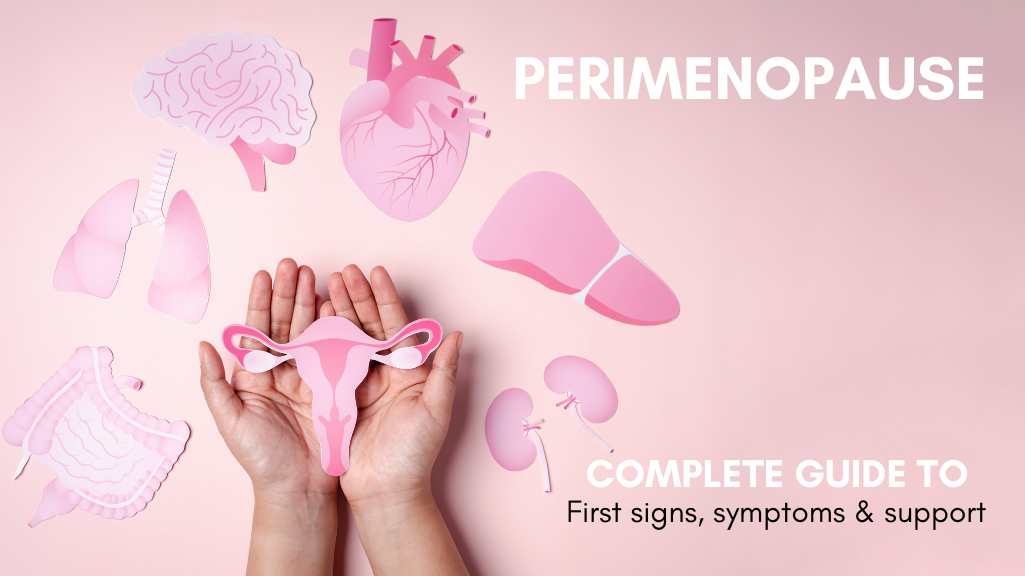Perimenopause is a natural transition that marks the beginning of the end of a woman’s reproductive years. This period can bring about significant physical, emotional, and hormonal changes, often leading to a lot of questions and uncertainties. Understanding exactly what is perimenopause and what to expect can make this transition smoother and less stressful.
This article will answer many of the questions women ask and guide you through the stages of menopause, the symptoms to watch for, how it’s diagnosed, treatment options, and how to manage symptoms, including both medical and herbal remedies.
What is Perimenopause?
Perimenopause, often referred to as the “transition to menopause,” is the phase before menopause when a woman’s body begins to undergo changes due to fluctuating hormone levels.
This stage can last anywhere from a few months to several years and ends when a woman reaches menopause—defined as 12 consecutive months without a menstrual period.
The Stages of Menopause: Perimenopause, Menopause, and Postmenopause
- Perimenopause: This stage can begin as early as a woman’s late 30s or early 40s, but the average age is around 45. During this time, estrogen and progesterone levels fluctuate, causing irregular periods and various other symptoms.
- Menopause: Menopause is officially diagnosed when a woman has not had a menstrual period for 12 consecutive months. The average age for menopause in the United States is 51 years old.
- Postmenopause: This stage refers to the time after menopause. Symptoms like hot flashes may continue, but many women find they lessen over time. However, the risk for certain health conditions, such as osteoporosis and heart disease, increases.
The Difference Between Perimenopause and Menopause
Perimenopause is the transition phase leading up to menopause, characterized by hormonal changes and the onset of symptoms like hot flashes, mood swings, and irregular periods.
Menopause itself is the point at which menstruation stops completely, and the reproductive years are over.
Postmenopause is the stage following menopause, where the body adjusts to lower hormone levels.
The First Signs of Perimenopause
The first signs of perimenopause can vary greatly among women, but common early indicators include:
- Irregular menstrual cycles: Periods may become longer or shorter, heavier or lighter, and the timing may be unpredictable.
- Hot flashes and night sweats: These sudden feelings of heat, often accompanied by sweating, are among the most well-known symptoms.
- Sleep disturbances: Difficulty falling asleep or staying asleep is common due to hormonal changes and night sweats.
- Mood swings: Fluctuating hormones can lead to moodiness, irritability, and even symptoms of depression or anxiety.
- Decreased libido: Many women notice a reduction in sexual desire and responsiveness.
Average Age and Statistics
- The average age for the onset of perimenopause is 45, but it can start as early as the mid-30s.
- Approximately 70-80% of women experience perimenopausal symptoms, with hot flashes affecting nearly 75% of women.
- The transition period typically lasts 4 to 10 years before reaching menopause.
Common Perimenopause Symptoms
1. Menstrual Irregularities
One of the earliest signs of perimenopause is a change in the menstrual cycle. Periods may become irregular, either shorter or longer, with some women experiencing heavier or lighter bleeding. The cycle length may also vary from month to month, becoming unpredictable. These changes are due to fluctuations in estrogen and progesterone levels
2. Hot Flashes and Night Sweats
Hot flashes are one of the most common symptoms of perimenopause, affecting about 75% of women during this transition. These sudden feelings of heat, often accompanied by sweating and flushed skin, can last from a few seconds to several minutes. Night sweats, a related symptom, can disrupt sleep and lead to fatigue during the day
3. Mood Changes and Anxiety
Mood swings, irritability, and increased anxiety are common during perimenopause due to the hormonal changes that affect brain chemistry. Some women may also experience heightened episodes of depression, particularly if they have a history of mood disorders or are sensitive to hormonal shifts
4. Sleep Problems
Difficulty sleeping is a frequent complaint among women going through perimenopause. Insomnia, waking up frequently during the night, or experiencing difficulty falling back asleep can be directly linked to hormonal changes as well as symptoms like night sweats
5. Vaginal Dryness and Changes in Sexual Function
As estrogen levels decline, vaginal tissues can become thinner, drier, and less elastic, leading to discomfort during intercourse. This change in vaginal lubrication can also contribute to a decrease in libido or sexual drive, affecting intimacy and sexual health
6. Weight Gain and Changes in Body Composition
During perimenopause, many women notice weight gain, particularly around the abdomen. Hormonal fluctuations can slow down metabolism, and changes in estrogen levels may lead to a redistribution of body fat. Additionally, lifestyle factors like reduced physical activity during middle age can compound this effect
7. Cognitive Changes: Memory and Concentration Issues
Some women experience what is often referred to as “brain fog” during perimenopause. Symptoms may include difficulty concentrating, memory lapses, and trouble staying focused on tasks. These cognitive changes are linked to the decrease in estrogen levels, which play a role in brain function
8. Physical Symptoms: Joint Pain and Migraines
Decreased estrogen can lead to a rise in inflammation, causing joint and muscle pain. Some women may also experience an increase in the frequency or severity of migraines during this time. Migraines during perimenopause can be more intense due to the instability of hormone levels.
9. Changes in Hair and Skin
Hormonal fluctuations during perimenopause can lead to changes in hair texture and even hair loss. Skin may also become drier and more prone to irritation due to decreased oil production, making wrinkles and fine lines more pronounced
Less Common but Significant Symptoms
1. Heart Palpitations
Some women may experience heart palpitations, which feel like the heart is racing or skipping beats. These are usually harmless but can be unsettling. They are often linked to hormonal imbalances and are worth discussing with a healthcare provider if they occur frequently.
2. Urinary Symptoms
Urinary incontinence or increased urgency. The decline in estrogen can cause thinning of the tissues in the urethra and bladder, leading to an increased risk of incontinence and urinary tract infections (UTIs) issues. These symptoms can be both distressing and inconvenient, but they are treatable with lifestyle changes or medical interventions
Factors Influencing the Severity and Onset of Symptoms
The experience of perimenopause varies widely among women. Factors that can influence the severity and onset of symptoms include:
- Genetics: If your mother or close female relatives went through menopause early, you’re more likely to experience early onset of perimenopause.
- Medical Conditions: Autoimmune diseases, thyroid disorders, and conditions like epilepsy can lead to an earlier onset of perimenopause.
- Lifestyle Factors: Smoking, low body mass index (BMI), diet, and physical activity levels all play a role in determining how early or severely you experience perimenopause
Diagnosing Perimenopause
There is no single test to diagnose perimenopause. Diagnosis is often based on a combination of factors, including:
- Medical history and symptom evaluation: A healthcare provider will review menstrual history and symptoms.
- Blood tests: To check hormone levels like estrogen, follicle-stimulating hormone (FSH), and thyroid function, as thyroid disorders can mimic perimenopausal symptoms.
- Physical exam: To rule out other conditions that may cause similar symptoms.
Treatment Options for Perimenopause
Medical Treatments
- Hormone Therapy (HT): The most effective treatment for hot flashes and night sweats. Hormones like estrogen and progesterone are prescribed to balance levels.
- Antidepressants: SSRIs and SNRIs can help with mood swings and hot flashes in some women.
- Vaginal estrogen: Used to relieve vaginal dryness and discomfort during intercourse.
- Non-hormonal medications: Such as Gabapentin and Clonidine, which may help with hot flashes and night sweats.
Herbal and Natural Remedies
- Red Clover: Contains phytoestrogens, plant-based compounds that mimic estrogen in the body and may reduce hot flashes.
- Black Cohosh: Commonly used to alleviate hot flashes and mood swings.
- Evening Primrose Oil: May help with hot flashes and mood stability.
- Flaxseed: Contains lignans that have estrogen-like properties.
- Soy Isoflavones: Phytoestrogens found in soy can help balance hormone levels naturally.

Lifestyle Modifications to Manage Symptoms
- Exercise regularly: Physical activity can help manage weight, improve mood, and reduce hot flashes.
- Eat a balanced diet: Rich in calcium, vitamin D, and other nutrients to support bone health.
- Stress management: Techniques like yoga, meditation, and deep breathing exercises can help with mood swings.
- Stay hydrated: Drink plenty of water to reduce bloating and help regulate body temperature.
- Limit caffeine and alcohol: Both can trigger hot flushes and disrupt sleep.
Health Complications That Can Arise
During perimenopause, women are at an increased risk for several health conditions, including:
- Osteoporosis: Decreasing estrogen levels can lead to bone density loss.
- Cardiovascular disease: The risk of heart disease increases after menopause due to changes in cholesterol and blood pressure.
- Urinary incontinence: Hormonal changes can weaken pelvic floor muscles.
- Mental health issues: Higher rates of anxiety, depression, and mood disorders are reported during this stage.
Frequently Asked Questions
1. At what age does perimenopause usually start?
- Perimenopause typically starts between ages 45 and 55, but it can begin as early as the mid-30s.
2. How long does perimenopause last?
- It can last anywhere from 4 to 10 years, with symptoms gradually increasing in frequency and intensity as menopause approaches.
3. Can I get pregnant during perimenopause?
- Yes, pregnancy is still possible during perimenopause as ovulation can be irregular but not completely stopped.
4. What is the difference between perimenopause and menopause?
- Perimenopause is the transition period leading up to menopause, characterized by irregular menstrual cycles and symptoms. Menopause is reached when you have not had a period for 12 consecutive months.
5. Is hormone therapy safe for treating perimenopausal symptoms?
- Hormone therapy can be safe for many women, but it depends on individual health factors. It is essential to discuss the risks and benefits with your healthcare provider.
6. Are there any natural remedies that can help with perimenopause symptoms?
- Yes, herbal supplements like red clover, soy, black cohosh, and evening primrose oil are popular natural remedies that may help manage symptoms.
Conclusion
Perimenopause is a natural but often challenging stage of life that can bring a variety of symptoms and health risks. Understanding the changes happening in your body, knowing what to expect, and exploring treatment options can help you manage this transition with confidence. Whether you opt for lifestyle changes, medical treatments, or natural remedies like red clover, the key is to find a strategy that works best for you.
Always consult with your healthcare provider before starting any treatment, especially herbal supplements, to ensure they are safe and appropriate for your specific situation.

References
- North American Menopause Society
- National Institute on Aging
- American College of Obstetricians and Gynecologists
- Mayo Clinic, “Perimenopause: Symptoms and causes.”
- World Health Organization, “Women’s health and aging.”

